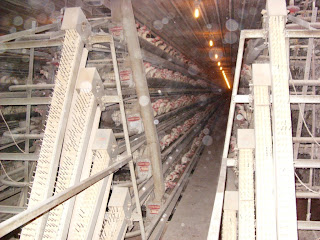Today was more like what I thought this rotation was going to be.
We spent the morning with a lab technician who showed us how to inoculate 9 day old chick fetuses with bird blood, to see if the avian influenza virus grows. There are a lot of live bird markets out here where live chickens, turkeys, ducks, quail, etc are traded on the street. Law requires that one out of so many of these birds have samples taken that are then run through of two tests (one being inoculating chick fetuses) to see if that bird has avian influenza. It’s a pretty interesting series of tests.
In the afternoon we went to a commercial layer farm (chickens that lay eggs). I’m told this was a “good” farm as far as air quality and “welfare” is concerned, which really doesn’t say much about the industry, I think…Here are some pictures to help walk through the experience….
These are the "houses" of laying hens. All 7 houses together hold almost 1 million birds. INSANE!
here are some workers packaging eggs
this worker is applying slight pressure to all the eggs so she will exacerbate any cracks...then the eggs go into a machine that shines a bright light on to find the cracks, then those eggs are pitched...also, a sound wave is sent through the eggs that also looks for cracks (somehow...)
Here is inside a layer house. The cages are stacked 5 rows high, slightly offset so the chicken manure doesn't fall only in the cage below, but some falls down the open middle in the "pit" below.
There are 7 chickens in each cage. They are crammed in so tightly that all the birds cannot stand or sit at the same time--they need to alternate. Apparently, the "welfare" standard is that each laying hen needs 44 sq inches of floor space--which boggles my mind because that's only an area 5"x8" which is smaller than the bird's body!!
It's kind of hard to see but on either side of the cages (on one end of the rows) are these conveyor belts with rubber fingers on them that gently brought the eggs from each level down to the conveyor belt that brought the eggs out of the house to the packaging room.
This is the "pit". All of the chicken poo falls into the "basement" of the chicken house. This house cleaned out the "pit" once a year. that's right. once a year--which is typical for most layer houses. in this house you can see the manure piling almost as high as the ceiling. notice the dust that my camera lens caught...gross. (the next day we visited a house that cleaned their pit 1-4 times a month and the smell was sooooooo much better there).
This is an "air conditioner" that cools water....the water is them misted over the birds during the summer to keep them cool. This farm only had it in 2/7 houses....most farms don't this. Each summer mortality increases due to heat exhaustion; this cooler keeps the houses ~5deg F cooler than the non cooled houses which means incredibly less mortality.
So that was my trip to the layer house. The ammonia smell was so intense in the house, that I was hacking up phlegm the whole next day...can't imagine what it's like for the hens to never breathe fresh air:(










No comments:
Post a Comment